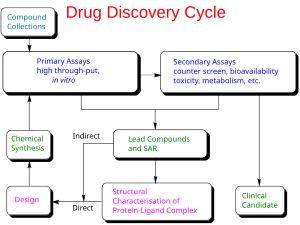
Back تطوير العقاقير Arabic Desarrollo de fármacos Spanish Ravimiarendus Estonian Lääkekehitys Finnish Pengembangan obat ID 医薬品開発 Japanese 의약품 개발 Korean Geneesmiddelonderzoek Dutch Разработка лекарств Russian Registracija lekova Serbo-Croatian
Drug development is the process of bringing a new pharmaceutical drug to the market once a lead compound has been identified through the process of drug discovery. It includes preclinical research on microorganisms and animals, filing for regulatory status, such as via the United States Food and Drug Administration for an investigational new drug to initiate clinical trials on humans, and may include the step of obtaining regulatory approval with a new drug application to market the drug.[1][2] The entire process—from concept through preclinical testing in the laboratory to clinical trial development, including Phase I–III trials—to approved vaccine or drug typically takes more than a decade.[3][1][2][4]
- ^ a b Strovel J, Sittampalam S, Coussens NP, Hughes M, Inglese J, Kurtz A, et al. (July 1, 2016). "Early Drug Discovery and Development Guidelines: For Academic Researchers, Collaborators, and Start-up Companies". Assay Guidance Manual. Eli Lilly & Company and the National Center for Advancing Translational Sciences. PMID 22553881.
- ^ a b Taylor D (2015). "The Pharmaceutical Industry and the Future of Drug Development". Issues in Environmental Science and Technology. Royal Society of Chemistry: 1–33. doi:10.1039/9781782622345-00001. ISBN 978-1-78262-189-8.
- ^ Everts M, Cihlar T, Bostwick JR, Whitley RJ (January 2017). "Accelerating Drug Development: Antiviral Therapies for Emerging Viruses as a Model". Annual Review of Pharmacology and Toxicology. 57 (1): 155–169. doi:10.1146/annurev-pharmtox-010716-104533. PMID 27483339.
- ^ "The Drug Development Process". U.S. Food and Drug Administration (FDA). 4 January 2018. Retrieved 21 March 2020.
